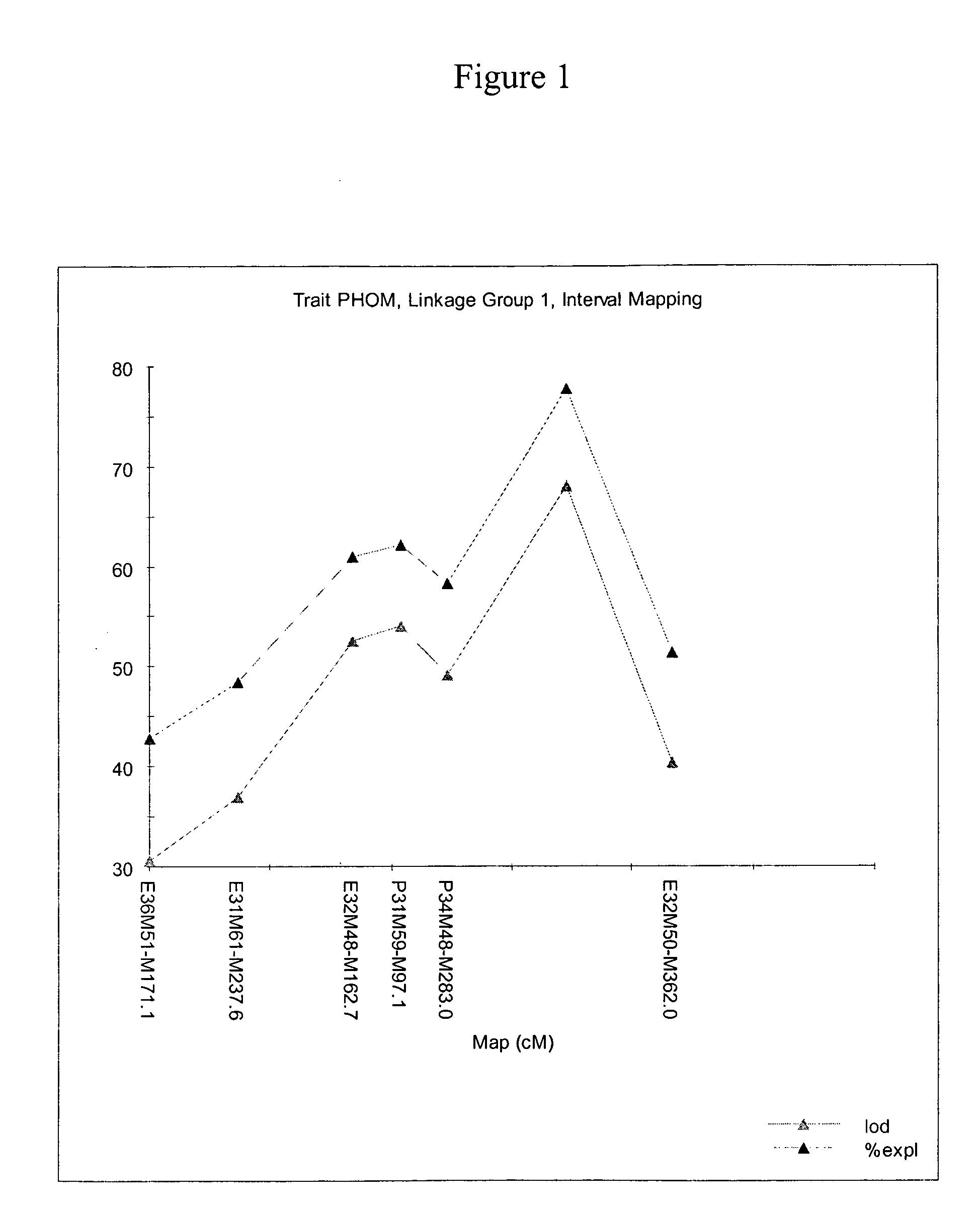Brassica plant resistant to the fungus leptosphaeria maculans (blackleg)
a technology of brassica and leptosphaeria, applied in the field of brassica plant resistance to the fungus leptosphaeria maculans (blackleg), can solve the problems of plant and plant death lodging, restriction in water, and major economic losses worldwid
- Summary
- Abstract
- Description
- Claims
- Application Information
AI Technical Summary
Benefits of technology
Problems solved by technology
Method used
Image
Examples
example 1
Mapping of Lem-08-syl by AFLP Analysis
Generation of BC3 and DH Mapping Populations
[0160] Kristina is a spring oilseed rape (SOSR) variety susceptible to blackleg infection. RFM292 is a synthetic B. napus line. RFM292 was generated by crossing a wild B. rapa ssp sylvestris accession from Sicily (#75) [Crouch et al. (1994)] with a wild B. atlantica accession from Tunisia (#25) [Mithen and Magrath (1992)], rescuing the embryos and doubling the chromosomes by colchicine treatment, as described in Crouch et al. (1994).
[0161] Kristina was crossed with RFM292. F1 plants derived from this cross were backcrossed to Kristina, generating a BC1 population, which was selfed to generate BC1S1 plants. Resistance of BC1S1 plants was tested in a field trial and resistant lines selected for further selfing, to generate BC1S3 plants. In order to select plants for selfing they were tested for resistance to various blackleg isolates (Canadian, Australian, British isolates). Resistant BC1S3 lines wer...
example 2
Generation of More Closely Linked AFLP Markers
[0181] In order to generate AFLP markers, which are more closely linked to Lem-08-syl, addition pools of BC3 plants were subjected to BSA analysis (as described above). New resistant and susceptible pools were generated and screened using +3 PstI / MseI AFLP primer combinations. Two additional markers linked to Lem-08-syl were identified, P34 / M48-M283.0 and P31 / M59-M97.1. P34 / M48-M283.0 is not yet mapped in B. rapa, but was found to be present in B. rapa and was found to be absent from B. napus, and hence provides another B. rapa-specific marker.
example 3
Linkage Mapping Using 259 Individual BC3 Plants
[0182] AFLP analysis of 259 of the 300 BC3 plants was carried out using the 6 AFLP primer combinations identified above, namely E32 / M50, P34 / M48, P31 / M59, E32 / M48, E31 / M61 and E36 / M51. Using the phenotypic data obtained from growth chamber tests for the 300 BC3 plants (as described above) and these AFLP data, linkage analysis was carried out using JoinMap V3.0.
[0183] The following genetic map was generated:
N08E32 / M47-M178.40.0E32 / M50-M362.07.5Lem-08-syl12.2P34 / M48-M283.017.9P31 / M59-M97.119.3E32 / M48-M162.721.4E31 / M61-M237.626.0E36 / M51-M171.129.3
[0184] The two mapped B. rapa specific markers flanked a region of about 21 cM, which was confirmed on an in-house B. rapa map.
[0185] QTL mapping (interval mapping) was also carried out using the same AFLP data and the overall blackleg score (quantitative score) for the 300 BC3 plants. The peak of the QTL identified corresponded to the position of Lem-08-syl on the genetic map, and explained ...
PUM
| Property | Measurement | Unit |
|---|---|---|
| Fraction | aaaaa | aaaaa |
| Substance count | aaaaa | aaaaa |
| Molality | aaaaa | aaaaa |
Abstract
Description
Claims
Application Information
 Login to View More
Login to View More - R&D
- Intellectual Property
- Life Sciences
- Materials
- Tech Scout
- Unparalleled Data Quality
- Higher Quality Content
- 60% Fewer Hallucinations
Browse by: Latest US Patents, China's latest patents, Technical Efficacy Thesaurus, Application Domain, Technology Topic, Popular Technical Reports.
© 2025 PatSnap. All rights reserved.Legal|Privacy policy|Modern Slavery Act Transparency Statement|Sitemap|About US| Contact US: help@patsnap.com

